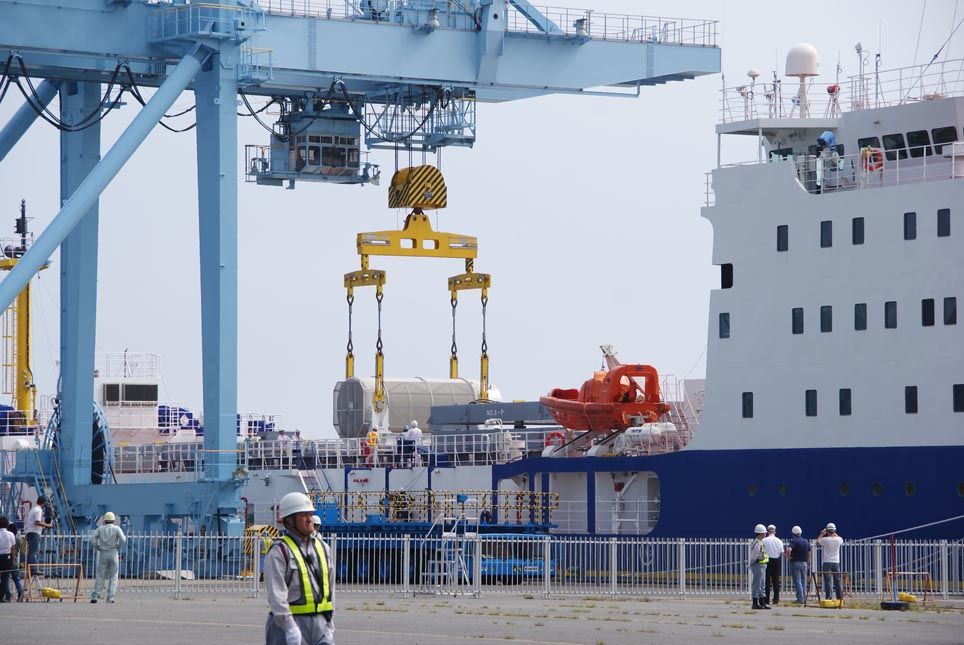News Watch 153 Mar./Apr. 2013 Nuke Info Tokyo No. 153
New guideline for nuclear disaster countermeasures
Radioactive materials released before venting at Fukushima Daiichi NPP Unit 1
Japan Atomic Power Co. sells uranium
Toshiba to be given preferential negotiation rights in construction of new Finnish NPP
Japan Atomic Power Co. and Marubeni to cooperate in Kazakhstan NPP plan
Japan to assist Saudi Nuclear Energy Plan
HLW returned from the UK
New guideline for nuclear disaster countermeasures
The Nuclear Regulation Authority finalized new guideline for nuclear disaster preparedness on February 27. The guidelines stipulate a zone of 5-km radius around a nuclear plant site as a PAZ (Precautionary Action Zone), and a 30-km zone as the UPZ (Urgent Protective Action Planning Zone). Iodine tablets will be distributed in advance among residents of PAZs to enable them to take the tablets when they evacuate immediately after an accident occurs.
When radiation measurements exceed 500 μSv/h in the UPZ, residents are to evacuate within several hours, while those in areas over 20 μSv/h are to evacuate within a week and maintain vigilance over radiation levels. Although the standard of 500 μSv/h is stricter than that of the IAEA, 1,000 μSv/h, ordinary people will reach the normal annual radioactivity exposure limit in only two hours. Over 3,000 public comments were sent to the Nuclear Regulation Authority demanding a review of the plan to enable more rapid evacuation, but the Authority made no changes to the guideline.
Radioactive materials released before venting at Fukushima Daiichi NPP Unit 1
The Mainichi Newspaper reported on February 22 that at the time of the accident at Fukushima Daiichi nuclear power plant, radioactive materials had spread over 10 km in all directions about five hours before venting. This was revealed after Fukushima Prefecture collected and analyzed accumulated data (which were not transmitted due to loss of power) from its 20 automatic monitoring posts in the vicinity of the nuclear power plant. Data analysis had been put on a back-burner because prefecture officials were tied up with massive amounts of work immediately after the accident. They say the analysis was completed around September 2012. Radioactive materials had been dispersed before the national government ordered the evacuation. If the data had been transmitted, it should have served as important information for appropriate evacuation. Lack of preparedness for the power loss resulted in the data remaining unused.
Japan Atomic Power Co. sells uranium
Jiji Press reported on February 20 that Japan Atomic Power Co.(JAPC), a nuclear power plant specialist power wholesaler funded by the ten electricity utilities, has sold part of the uranium in its possession. JAPC says it has to secure funds repay bank debts due in April, while restart of its three idling reactors (Tokai -2 Nuclear Power Plant, BWR, 1,100 MW; Tsuruga-1 Nuclear Power Plant, BWR, 357 MW; Tsuruga-2 Nuclear Power Plant, PWR, 1,160 MW) are uncertain. JAPC disclosed neither the buyer nor the amount sold. TEPCO is also reported as considering the sale of uranium.
Toshiba to be given preferential negotiation rights in construction of new Finnish NPP
On February 25, Toshiba was given preferential negotiating rights in a bid for the Hanhikivi NPP, which Finnish corporation Fennovoima is planning to construct. The bidding took place in January with the participation of Toshiba and Areva, Toshiba proposing a 1,600 MW class EU-ABWR. Also considering the possibility of a 1,000 to 1,300 MW class reactor, besides interest in the Toshiba ABWR, Fennovoima will continue talks with Areva and Rosatom with a view to making a final decision before the end of March.
Japan Atomic Power Co. and Marubeni to cooperate in Kazakhstan NPP plan
On February 18, JAPC and Marubeni Utility Services Ltd. signed a memorandum on cooperation with the National Nuclear Center of the Republic of Kazakhstan toward introduction of a nuclear power plant in that country. Kazakhstan plans to construct a new nuclear power plant in the 2020s, and it is reported that the Japanese side will assist in human resource development, feasibility studies, as well as the construction and operation of nuclear power plants in Kazakhstan.
Japan to assist Saudi Nuclear Energy Plan
In his visit to the Middle East, the Minister of Economy, Trade and Industry, Toshimitsu Motegi, held talks in Riyadh, Saudi Arabia, with Vice President Faraj of “The King Abdullah City for Atomic and Renewable Energy” on February 9. In response to the vice president’s request for cooperation, METI’s Motegi expressed the intention to support Saudi Arabia by, for example, accepting trainees to develop human resources that would play a role in the operation and regulation of nuclear reactors. However, in answer to a question in a press briefing on February 10 about signing an atomic cooperation agreement, METI’s Motegi said that they had not yet reached that stage.
High-level radioactive waste has been returned to Japan from the UK. The HLW consisted of spent fuel from Japanese nuclear plants reprocessed in the UK. On February 27, a total of 28 vitrified HLW canisters were transported in the third shipment to the Japan Nuclear Fuel Limited storage facility in Rokkasho Village, Aomori Prefecture. With this, 132 canisters in all have been returned, leaving about 770 (including middle- and low-level radioactive wastes exchanged for an equal amount of radioactivity) still to be returned. Shipments from France have been completed with the return of 1,310 canisters.

High-Level Vitrified Waste from Japanese spent nuclear fuel arrives at Mutsu-Ogawara Port in Aomori Prefecture. Photograph taken on September 15, 2011.
